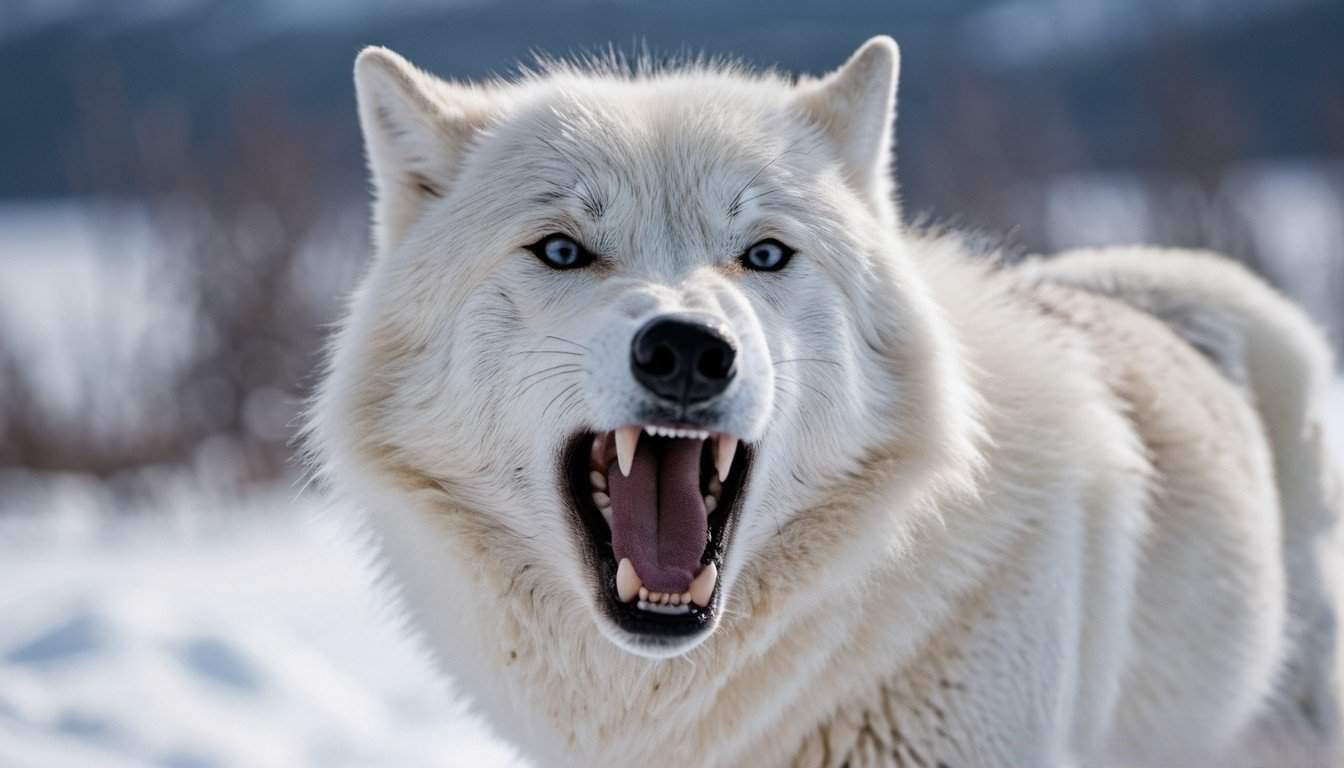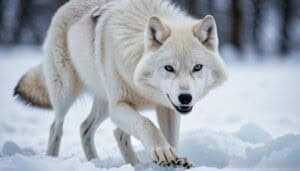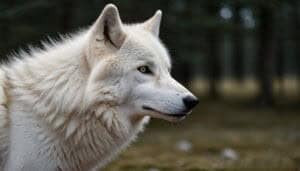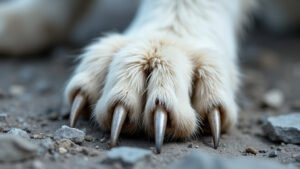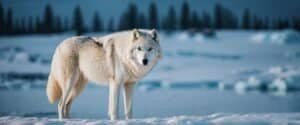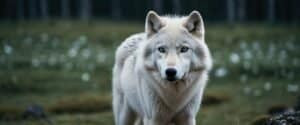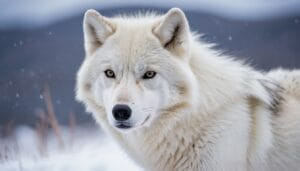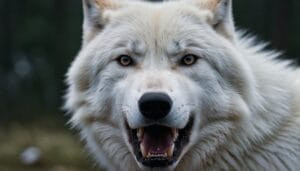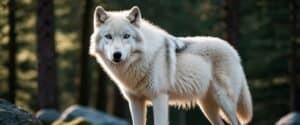Introduction
The dental formula of an Arctic wolf reveals much about its biology, behavior, and adaptations to the harsh Arctic environment. This article explores the structure and function of an Arctic wolf’s teeth, their role in hunting and feeding, and the differences between juvenile and adult wolves
We will also discuss how their teeth adapt to the environment, impact social behaviors, and what research has uncovered about their dental health
Dental Formula of an Arctic Wolf
Overview of the Dental Formula
The dental formula of an Arctic wolf is a critical aspect of its anatomy that helps understand its dietary habits and ecological role
The typical dental formula for an adult Arctic wolf is expressed as 3.1.4.2/3.1.4.3. This notation represents the number and types of teeth in one half of the upper and lower jaws, respectively:
Incisors (I): 3/3
Canines (C): 1/1
Premolars (P): 4/4
Molars (M): 2/3
This means that an Arctic wolf has a total of 42 teeth. The incisors are primarily used for nipping and grooming, while the canines are critical for grabbing and holding prey. Premolars and molars are used for shearing and grinding food
Comparison with Other Wolves
When comparing the dental formula of the Arctic wolf to other wolf species, such as the gray wolf (Canis lupus), the formula remains consistent. This consistency highlights the shared evolutionary adaptations within the Canis genus
However, subtle differences in tooth shape and wear patterns can occur due to variations in diet and habitat. Arctic wolves, living in harsh environments with different prey availability, may exhibit more pronounced wear on their teeth due to harder, frozen food items
Tooth Functions in Arctic Wolves
Each type of tooth in an Arctic wolf’s mouth serves a specific purpose:
Incisors: These small, sharp teeth are located at the front of the mouth and are used for gripping and pulling meat off bones. They also play a role in grooming and removing parasites from fur
Canines: These long, pointed teeth are essential for hunting. They are used to seize and puncture prey, ensuring a firm grip during the kill. Canines are also involved in defensive and territorial behaviors
Premolars: These teeth have a varied role in tearing and slicing flesh. They are located behind the canines and have sharp edges to help cut meat into smaller, digestible pieces
Molars: Positioned at the back of the mouth, molars have flatter surfaces designed for grinding and crushing bones. This is crucial for extracting marrow and other nutrients from hard parts of prey
Teeth Usage and Adaptations
Hunting Techniques
Arctic wolves have evolved specific hunting techniques that utilize their teeth efficiently. These wolves typically hunt in packs, allowing them to take down larger prey such as musk oxen and caribou. The canines play a pivotal role in these hunts, as they are used to grab and hold onto the prey, ensuring it cannot escape
The pack works together, using their combined strength and sharp teeth to bring down their target. Once the prey is subdued, the wolves use their incisors to remove the hide and their premolars and molars to tear apart the flesh and crush bones
Feeding Habits
Feeding habits of Arctic wolves are directly influenced by their dental structure. In the harsh Arctic environment, food can be scarce, and wolves often face periods of starvation. When food is available, they consume as much as possible, using their teeth to break down and process their catch efficiently
Their premolars and molars are especially useful in this context, allowing them to eat almost every part of their prey, including bones. This ability to consume bones is vital for obtaining calcium and other nutrients that might be lacking in their diet
Structural Adaptations
The teeth of Arctic wolves show several structural adaptations that help them survive in their icy habitat. The enamel on their teeth is particularly thick, providing extra protection against wear and tear from consuming tough and frozen prey
Additionally, their jaws are incredibly strong, which aids in crushing bones and allows them to consume as much of their prey as possible. This is particularly important in an environment where food is not always readily available, and every meal must be maximized for nutritional content
Functional Adaptations
Functionally, the teeth of Arctic wolves are adapted to handle a diverse range of dietary challenges. Their canines are not only used for capturing prey but also play a role in social interactions within the pack. Displaying canines can be a sign of dominance or aggression
Their incisors, while small, are adept at stripping meat from bones and are used in grooming behaviors that strengthen social bonds within the pack. Premolars and molars with their shearing and crushing capabilities allow Arctic wolves to process their prey thoroughly, extracting maximum nutrition and ensuring survival in their extreme environment
Differences in Teeth Across Life Stages
Dental Development in Juvenile Wolves
The dental development of Arctic wolves begins shortly after birth. Like all canines, Arctic wolf pups are born without teeth. At around three weeks of age, their deciduous (baby) teeth begin to emerge. This initial set of teeth includes incisors, canines, premolars, but no molars
These baby teeth are crucial for the early stages of feeding, as the pups transition from their mother’s milk to solid food. By the time the pups are around eight weeks old, they will have a full set of deciduous teeth
These baby teeth are relatively small and not as durable as adult teeth. They are primarily used for practice as the pups learn to eat meat and play fight with their siblings, which is essential for their social and physical development. As they grow and their diet shifts entirely to solid food, their deciduous teeth begin to fall out
Changes in Adult Teeth
The transition from deciduous to adult teeth in Arctic wolves occurs between four to six months of age. During this period, the baby teeth are replaced by a stronger, more durable set of adult teeth. The adult dental formula of an Arctic wolf is 3.1.4.2/3.1.4.3, giving them a total of 42 teeth. This set includes incisors, canines, premolars, and molars, each designed to handle the demands of their carnivorous diet
Adult teeth in Arctic wolves are larger and more robust, capable of withstanding the pressures of hunting and consuming large prey. The canines, which are essential for capturing and holding onto prey, grow in sharp and long
The premolars and molars develop with stronger roots and thicker enamel to endure the task of shearing flesh and crushing bones. The complete set of adult teeth ensures that Arctic wolves are fully equipped for their roles as apex predators in the harsh Arctic environment
Dental Health and Social Behavior
Common Dental Issues
Arctic wolves, like all animals, can face several dental health issues that can impact their overall well-being. The harsh Arctic environment and their diet of tough, frozen prey can lead to significant wear and tear on their teeth
Common dental problems in Arctic wolves include:
Tooth Wear and Fractures: The constant gnawing on bones and frozen meat can lead to significant wear on the enamel and even fractures in the teeth. This can cause pain and difficulty in processing food
Periodontal Disease: Infections of the gums and surrounding tissues are common due to the buildup of plaque and tartar. This can lead to tooth loss if not managed
Tooth Abscesses: Infections at the root of the tooth can cause abscesses, leading to pain and swelling. This condition often requires intervention, as it can affect the wolf’s ability to eat and hunt
Dental Caries (Cavities): Although less common in carnivores, cavities can still occur and lead to tooth decay and loss
Impact on Overall Health
The health of an Arctic wolf’s teeth is directly linked to its overall health. Healthy teeth are essential for effective hunting, feeding, and nutrient absorption
Dental problems can lead to:
Reduced Feeding Efficiency: Damaged or painful teeth can hinder a wolf’s ability to capture and consume prey, leading to malnutrition and weakness
Infection Spread: Dental infections can spread to other parts of the body, causing systemic health issues that can further debilitate the wolf
Weakened Immune System: Poor dental health can stress the immune system, making the wolf more susceptible to other diseases and environmental stresses
Role in Pack Dynamics
Teeth play a significant role in the social dynamics of Arctic wolf packs. The display of teeth can convey a range of social signals, from dominance to submission
For instance:
Dominance Displays: Alpha wolves often display their canines as a show of strength and dominance. This display can deter challenges from other pack members and reinforce the alpha’s leadership position
Submissive Behaviors: Subordinate wolves may show their teeth in a submissive grin, exposing their incisors but not their canines. This behavior helps maintain harmony within the pack by acknowledging the alpha’s authority
Communication Through Teeth Display
The display of teeth is a crucial aspect of communication among Arctic wolves. Wolves use their teeth to express a variety of emotions and intentions, such as:
Aggression: Bared teeth, especially the canines, signal aggression and a readiness to fight. This display can ward off threats or challenges from other animals
Playfulness: During play, wolves often nip and show their teeth without aggressive intent. This behavior helps young wolves develop their hunting skills and social bonds
Affection: Gentle nipping and grooming with the teeth are signs of affection and bonding between pack members, reinforcing social structures and relationships
These behaviors highlight the importance of teeth not only in feeding and hunting but also in maintaining the social fabric of the pack
Research on Arctic Wolf Teeth
Methods of Study
Research on the teeth of Arctic wolves provides valuable insights into their health, behavior, and ecological adaptations
Scientists employ various methods to study these aspects:
Field Observations: Researchers observe wolves in their natural habitat to study their feeding behavior and social interactions. This involves watching how they hunt, eat, and use their teeth in different contexts
Dental Casting and Impressions: Taking molds of wolf teeth allows researchers to create detailed models for analysis. These models help in examining wear patterns, tooth structure, and any dental anomalies
Radiography: X-rays are used to study the internal structure of teeth and jaws. This method can reveal root health, the presence of infections, and other internal dental issues
Comparative Analysis: Comparing the teeth of Arctic wolves with other wolf species and canids helps in understanding evolutionary adaptations. This analysis includes examining differences in tooth size, shape, and wear patterns
Dental Microwear Analysis: This technique involves examining microscopic wear patterns on the teeth to infer diet and feeding behaviors. It provides insights into what kinds of prey Arctic wolves typically consume and how they process their food
Findings and Implications
Research on Arctic wolf teeth has led to several important findings that enhance our understanding of these animals:
Dietary Insights: Dental analysis reveals that Arctic wolves have a diverse diet that includes large ungulates like caribou and smaller mammals. The wear patterns on their teeth indicate a significant consumption of bones, highlighting their ability to extract maximum nutrition from their prey
Adaptations to Environment: Studies show that the thick enamel and robust structure of Arctic wolf teeth are adaptations to their harsh environment, where they must consume tough, frozen prey. These adaptations ensure their survival in extreme conditions
Health Indicators: The state of an Arctic wolf’s teeth can indicate its overall health and nutrition. For example, excessive wear or dental diseases might reflect challenges in food availability or nutritional deficiencies
Social Behavior: Research has documented how dental displays play a role in social interactions within wolf packs. This understanding helps in interpreting wolf behaviors observed in the wild and can aid in conservation efforts by providing insights into pack dynamics
Evolutionary Biology: Comparative studies with other canids help trace the evolutionary history of Arctic wolves. Differences in dental structure and wear patterns offer clues about the evolutionary pressures that shaped these animals
These findings have broader implications for conservation efforts, as understanding the health and behavior of Arctic wolves can inform strategies to protect them and their habitats. By studying their teeth, scientists can gather data that supports the maintenance of healthy wolf populations and the ecosystems they inhabit
Conclusion
The dental formula of an Arctic wolf is a crucial aspect of its anatomy that reveals much about its lifestyle and adaptations. With a dental formula of 3.1.4.2/3.1.4.3, Arctic wolves have a total of 42 teeth, each type serving a specific function from gripping and tearing to grinding bones
Understanding the teeth usage and adaptations provides insights into how these wolves survive and thrive in the harsh Arctic environment. Juvenile wolves develop deciduous teeth early on, which are eventually replaced by stronger adult teeth suited for their carnivorous diet
Dental health is vital for the wolves’ overall well-being, influencing their ability to hunt, eat, and maintain social structures within the pack. Teeth are not only tools for survival but also play a significant role in social behavior, from establishing dominance to fostering pack bonds
Research on Arctic wolf teeth, through various methods like field observations, radiography, and comparative analysis, has provided valuable insights into their diet, health, and evolutionary adaptations
These studies have broader implications for conservation, highlighting the importance of maintaining healthy wolf populations and understanding their ecological roles. By delving into the dental anatomy and health of Arctic wolves, we can better appreciate the intricate balance of nature that allows these majestic animals to endure in one of the most extreme environments on Earth
